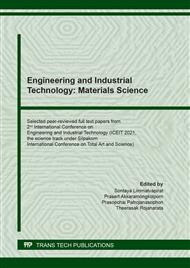[1]
P. Anand, A.B. Kunnumakkara, C. Sundaram, K.B. Harikumar, S.T. Tharakan, O.S. Lai, B. Sung, B.B. Aggarwal, Cancer is a preventable disease that requires major lifestyle changes, Pharm. Res., 25(9), 2008, 2097-2116.
DOI: 10.1007/s11095-008-9661-9
Google Scholar
[2]
C. Chavany, E. Mimnaugh, P. Miller, R. Bitton, P. Nguyen, J. Trepel, L. Whitesell, R. Schnur, J. Moyer, L. Neckers, p185erbB2 binds to GRP94 in vivo. Dissociation of the p185erbB2/GRP94 heterocomplex by benzoquinone ansamycins precedes depletion of p185erbB2, J. Biol. Chem., 271, 1996, 4974-4977.
DOI: 10.1074/jbc.271.9.4974
Google Scholar
[3]
B. Segnitz, U. Gehring, The function of steroid hormone receptors is inhibited by the hsp90-specific compound geldanamycin, J. Biol. Chem, 272, 1997, 18694-18701.
DOI: 10.1074/jbc.272.30.18694
Google Scholar
[4]
P. Miller, C. DiOrio, M. Moyer, R.C. Schnur, A. Bruskin, W. Cullen, J.D. Moyer, Depletion of the erbB-2 gene product p.185 by benzoquinoid ansamycins, Cancer Res., 54, 1994, 2724-2730.
DOI: 10.1006/bbrc.1994.1847
Google Scholar
[5]
P. Csermely, T. Schnaider, C. Sõti, Z. Prohászka, G. Nardai, The 90-kDa molecular chaperone family: structure, function, and clinical applications. A comprehensive review, Pharmacol. Ther., 79(2), 1998, 129-168.
DOI: 10.1016/s0163-7258(98)00013-8
Google Scholar
[6]
J. Buchner, Hsp90 & Co. - a holding for folding, Trends Biochem. Sci., 24, 1999, 136-141.
Google Scholar
[7]
A.E. Pasqua, B. Wilding, M.D. Cheeseman, K. Jones, Targeting Protein Synthesis, Folding, and Degradation Pathways in Cancer, in: S. Chackalamannil, D. Rotella, S.E. Ward (Eds.), Comprehensive Medicinal Chemistry III, Elsevier, 2017, pp.202-280.
DOI: 10.1016/b978-0-12-409547-2.12395-9
Google Scholar
[8]
Y. Xiao, Y. Liu, Recent advances in the discovery of novel HSP90 inhibitors: an update from 2014. Curr. Drug Targets, 21(3), 2020, 302-317.
DOI: 10.2174/1389450120666190829162544
Google Scholar
[9]
E.S. Charles, A.R. Alicia, S. Christine, R. Neal, F.U. Hartl, P.P. Nikola, Crystal structure of an Hsp90-geldanamycin complex: targeting of a protein chaperone by an antitumor agent, Cell, 89, 1997, 239-250.
DOI: 10.1016/s0092-8674(00)80203-2
Google Scholar
[10]
J.M. Jez, J.C.H. Chen, G. Rastelli, R.M. Strond, D.V. Santi, Crystal structure and molecular modeling of 17-DMAG in complex with human hsp90, Cell Chem. Biol., 10, 2003, 361-368.
DOI: 10.1016/s1074-5521(03)00075-9
Google Scholar
[11]
K. Lee, J.S. Ryu, Y. Jin, W. Kim, N. Kaur, S.J. Chung, Y. Jeon, J. Park, J.S. Bang, H.S. Lee, T.Y. Kim J.J. Lee, Y.S. Hong, Synthesis and anticancer activity of geldanamycin derivatives derived from biosynthetically generated metabolites. Org. Biomol. Chem., 6(2), 2008, 340-348.
DOI: 10.1039/b713407j
Google Scholar
[12]
T. Taechowisan, T. Samsawat, W. Puckdee, W.S. Phutdhawong, Cytotoxicity activity of geldanamycin derivatives against various cancer cell lines, J. Appl. Pharm. Sci., 10(06), 2020, 12-21.
DOI: 10.7324/japs.2020.10603
Google Scholar
[13]
N. Skrzypczak, K. Pyta, P. Ruszkowski, P. Mikołajczak, M. Kucińska, M. Murias, M. Gdanieca, F. Bartl, P. Przybylski, Anticancer activity and toxicity of new quaternary ammonium geldanamycin derivative salts and their mixtures with potentiators, J. Enzyme Inhib. Med. Chem., 36(1), 2021, 1898-1904.
DOI: 10.1080/14756366.2021.1960829
Google Scholar
[14]
L. Neckers, Hsp90 inhibitors as novel cancer chemotherapeutic agents, Trends Mol. Med., 8(4), 2002, S55-S61.
DOI: 10.1016/s1471-4914(02)02316-x
Google Scholar
[15]
Z. Guo, Y. Xu, Y. Peng, H. ur Rashid, W. Quan, P. Xie, W. Lichuan, J. Jiang, L. Wang, X. Liu, Design, synthesis and evaluation of novel (S)-tryptamine derivatives containing an allyl group and an aryl sulfonamide unit as anticancer agents, Bioorg. Med. Chem. Lett., 29(9), 2019, 1133-1137.
DOI: 10.1016/j.bmcl.2019.02.023
Google Scholar
[16]
S. Kousara, S.N. Anjuma, F. Jaleela, J. Khana, S. Naseema, Biomedical significance of tryptamine: a review, J. Pharmacovigil, 2017, 5(5), 239.
DOI: 10.4172/2329-6887.1000239
Google Scholar


